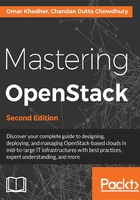
The Neutron architecture
The three main components of the Neutron architecture are:
- Neutron server: It accepts API requests and routes them to the appropriate Neutron plugin for action.
- Neutron plugins: They perform the actual work for the orchestration of backend devices such as the plugging in or unplugging ports, creating networks and subnets, or IP addressing.
Agents and plugins differ depending on the vendor technology of a particular cloud for the virtual and physical Cisco switches, NEC, OpenFlow, OpenSwitch, Linux bridging, and so on.
- Neutron agents: Neutron agents run on the compute and network nodes. The agents receive commands from the plugins on the Neutron server and bring the changes into effect on the inpidual compute or network nodes. Different types of Neutron agents implement different functionality. For example, the Open vSwitch agent implements L2 connectivity by plugging and unplugging ports onto Open vSwitch (OVS) bridges and they run on both compute and network nodes, whereas L3 agents run only on network nodes and provide routing and NAT services.
Neutron is a service that manages network connectivity between the OpenStack instances. It ensures that the network will not be turned into a bottleneck or limiting factor in a cloud deployment and gives users real self-service, even over their network configurations.
Another advantage of Neutron is its ability to provide a way to integrate vendor networking solutions and a flexible way to extend network services. It is designed to provide a plugin and extension mechanism that presents an option for network operators to enable different technologies via the Neutron API. More details about this will be covered in Chapter 6, OpenStack Networking - Choice of Connectivity Types and Networking Services and Chapter 7, Advances Networking - A Look SDN and NFV.
Keep in mind that Neutron allows users to manage and create networks or connect servers and nodes to various networks.
The scalability advantage will be discussed in a later topic in the context of the Software Defined Network (SDN) and Network Function Virtualization (NFV) technology, which is attractive to many networks and administrators who seek a high-level network multi-tenancy.